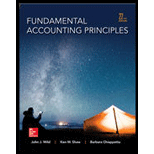
Issue of bond at premium:
When the coupon rate or contract rate of a bond is higher than the market interest rate, the bond is being issued at premium. If the bond is issued at premium, the selling price of the bond will be higher than the face value of the bond.
Effective interest method:
Effective interest method aims at computing an accurate interest expense. In case of issue of bonds on premium, the carrying value of the bonds payable inclusive of premium amortized is used to determine the interest expense during a particular period. Hence the interest expense decreases as the carrying value of the bonds decrease.
To determine:
1. Computation of total bond interest expense over the bond’s life.
2. Prepare an amortization table for the bond’s life using effective interest method.
3. Prepare
4. Using market rate at issuance, compute the present value of the remaining
Want to see the full answer?
Check out a sample textbook solution
Chapter 14 Solutions
Fundamental Accounting Principles -Hardcover
- Please provide the answer to this financial accounting question with proper steps.arrow_forwardCan you solve this financial accounting question with the appropriate financial analysis techniques?arrow_forwardCan you solve this financial accounting question with accurate accounting calculations?arrow_forward
- I need help with this financial accounting problem using proper accounting guidelines.arrow_forwardCan you explain the correct methodology to solve this financial accounting problem?arrow_forwardCan you help me solve this financial accounting question using the correct financial procedures?arrow_forward
- I need guidance with this financial accounting problem using the right financial principles.arrow_forwardCan you solve this general accounting problem using appropriate accounting principles?arrow_forwardPlease provide the answer to this financial accounting question using the right approach.arrow_forward
- I need help with this general accounting problem using proper accounting guidelines.arrow_forwardI am looking for the correct answer to this general accounting problem using valid accounting standards.arrow_forwardPlease provide the solution to this general accounting question using proper accounting principles.arrow_forward

 AccountingAccountingISBN:9781337272094Author:WARREN, Carl S., Reeve, James M., Duchac, Jonathan E.Publisher:Cengage Learning,
AccountingAccountingISBN:9781337272094Author:WARREN, Carl S., Reeve, James M., Duchac, Jonathan E.Publisher:Cengage Learning, Accounting Information SystemsAccountingISBN:9781337619202Author:Hall, James A.Publisher:Cengage Learning,
Accounting Information SystemsAccountingISBN:9781337619202Author:Hall, James A.Publisher:Cengage Learning, Horngren's Cost Accounting: A Managerial Emphasis...AccountingISBN:9780134475585Author:Srikant M. Datar, Madhav V. RajanPublisher:PEARSON
Horngren's Cost Accounting: A Managerial Emphasis...AccountingISBN:9780134475585Author:Srikant M. Datar, Madhav V. RajanPublisher:PEARSON Intermediate AccountingAccountingISBN:9781259722660Author:J. David Spiceland, Mark W. Nelson, Wayne M ThomasPublisher:McGraw-Hill Education
Intermediate AccountingAccountingISBN:9781259722660Author:J. David Spiceland, Mark W. Nelson, Wayne M ThomasPublisher:McGraw-Hill Education Financial and Managerial AccountingAccountingISBN:9781259726705Author:John J Wild, Ken W. Shaw, Barbara Chiappetta Fundamental Accounting PrinciplesPublisher:McGraw-Hill Education
Financial and Managerial AccountingAccountingISBN:9781259726705Author:John J Wild, Ken W. Shaw, Barbara Chiappetta Fundamental Accounting PrinciplesPublisher:McGraw-Hill Education





